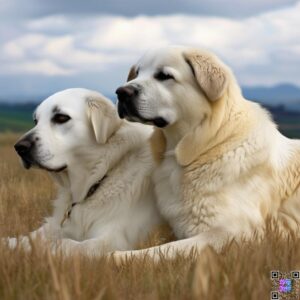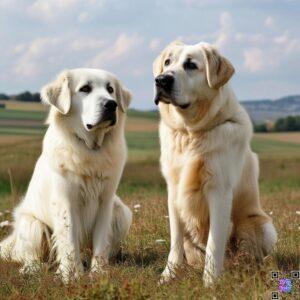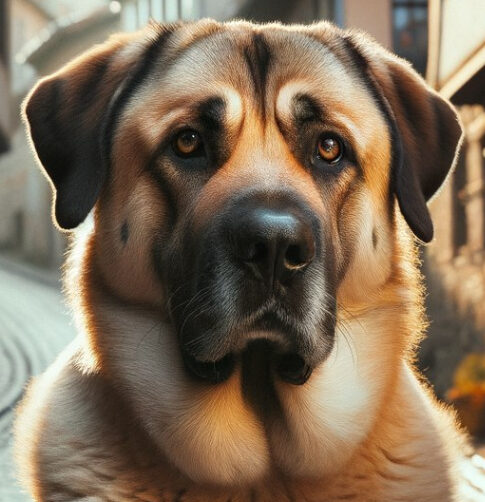Introduction
Maremma Sheepdogs and Anatolian Shepherd Dogs are two breeds that share a common purpose: protecting livestock. Both breeds have a long history of serving as guardians for sheep, goats, and other farm animals, and their loyalty, intelligence, and courage have made them invaluable assets to farmers and ranchers around the world. While Maremma Sheepdogs and Anatolian Shepherd Dogs share many similarities, they also have distinct differences in terms of their origins, appearance, and temperament. In this article, we’ll explore the history and characteristics of each breed, compare their traits, and provide guidance on choosing between the two for potential owners.
History of Maremma Sheepdogs

The Maremma Sheepdog has its origins in the Abruzzi region of Italy, where it has been used as a livestock guardian dog for centuries. These dogs were essential to the transhumance system of sheep farming, where flocks would graze in the mountains during the summer and move to the plains of the Adriatic coast for the winter. The modern Maremma Sheepdog was promoted as a pure breed in the mid-20th century by Donna Anna Corsini and Francesco Guintini, who established the breed standard we know today. The Maremma Sheepdog was first displayed at a dog show in Brescia, Italy in 1952.
Characteristics of Maremma Sheepdogs
Maremma Sheepdogs are large, muscular dogs with a solid white or ivory coat. They typically stand between 25.5 and 28.75 inches tall at the shoulder and weigh between 77 and 99 pounds for males, and 23.5 to 26.75 inches tall and 66 to 88 pounds for females. These dogs have a distinctive conical-shaped head with a wide, flat skull and a strong muzzle. Their almond-shaped eyes are typically golden to brown in color, and their triangular ears hang close to their cheeks. Maremmas have a thick, muscular neck and a body that is slightly longer than it is tall. In terms of temperament, Maremma Sheepdogs are courageous, loyal, and independent. They are naturally protective of their flock and family, and can be aloof with strangers. Maremmas are intelligent and trainable, but their independent streak can make them stubborn at times.
History of Anatolian Shepherd Dogs
The Anatolian Shepherd Dog has its origins in the Anatolia region of Turkey, where it has been used as a livestock guardian dog for thousands of years. These dogs were essential to the survival of sheep and goat herds in the harsh, mountainous terrain of Anatolia, where they protected the flocks from predators such as wolves and bears. The Anatolian Shepherd Dog was first introduced to the United States in the 1970s, and the breed was recognized by the American Kennel Club in 1996. Today, Anatolian Shepherd Dogs are popular not only as livestock guardians, but also as family pets and show dogs.
Characteristics of Anatolian Shepherd Dogs
Anatolian Shepherd Dogs are large, muscular dogs with a thick double coat that can be a variety of colors, including cream, fawn, and sesame. They typically stand between 29 and 32 inches tall at the shoulder and weigh between 110 and 145 pounds for males, and 28 to 31 inches tall and 85 to 120 pounds for females.These dogs have a large, broad head with a strong muzzle and triangular ears that are carried flat to the head. Anatolians have a deep chest, well-sprung ribs, and a thick, muscular neck. Their tail is carried low when relaxed and high when alert. In terms of temperament, Anatolian Shepherd Dogs are intelligent, independent, and protective. They are naturally wary of strangers and can be aggressive towards other dogs, particularly those of the same sex. Anatolians are loyal to their family and flock, and will fiercely defend them from any perceived threat.
Comparing Maremma Sheepdogs and Anatolian Shepherd Dogs
While Maremma Sheepdogs and Anatolian Shepherd Dogs share many similarities as livestock guardian breeds, there are some key differences between the two:
- Size: Anatolian Shepherd Dogs are generally larger than Maremma Sheepdogs, with males reaching up to 32 inches tall and 145 pounds, compared to 28.75 inches and 99 pounds for male Maremmas.
- Coat: Maremma Sheepdogs have a shorter, denser coat than Anatolian Shepherd Dogs, which have a longer, coarser double coat. Both breeds are white, but Anatolians can also come in other colors like cream and fawn.
- Temperament: Maremma Sheepdogs are generally more friendly and less aggressive than Anatolian Shepherd Dogs, which can be more aloof and territorial. Both breeds are highly protective of their flock and family.
- Trainability: Maremma Sheepdogs are considered more trainable than Anatolian Shepherd Dogs, which can be stubborn and independent. However, both breeds require firm, consistent training from an early age.
Training and Care of Maremma Sheepdogs
Maremma Sheepdogs are intelligent dogs that respond well to positive reinforcement training methods. They require firm, consistent training from an early age to curb their independent streak and teach them appropriate behavior around livestock and people. These dogs have a low-maintenance coat that only requires brushing once a week, except during shedding season when they may need daily brushing. Maremmas are active dogs that need plenty of exercise, including walks, playtime, and access to a large yard or pasture. Health-wise, Maremma Sheepdogs are generally healthy, but can be prone to certain conditions like hip dysplasia and hypothyroidism. Regular veterinary check-ups and a balanced diet are essential for keeping these dogs in top condition.
Training and Care of Anatolian Shepherd Dogs
Anatolian Shepherd Dogs are intelligent dogs that can be challenging to train due to their independent nature and stubborn streak. They require firm, consistent training from an experienced owner who can establish themselves as the pack leader. Positive reinforcement methods are most effective with these dogs.Anatolians have a thick double coat that requires regular brushing to prevent matting and remove loose hair. They are heavy shedders, especially during the spring and fall. These dogs need plenty of exercise, including long walks, playtime, and access to a large yard or pasture.Health-wise, Anatolian Shepherd Dogs are generally healthy, but can be prone to certain conditions like hip and elbow dysplasia, hypothyroidism, and entropion (a condition where the eyelid rolls inward). Regular veterinary check-ups and a balanced diet are essential for keeping these dogs in top condition.
Maremma Sheepdog: Ancient Roots
The history of the Maremma Sheepdog dates back to ancient times when they were first bred in the Italian region of Maremma. These dogs were developed to protect sheep from predators like wolves. Their strong instincts and protective nature made them invaluable to shepherds. Over time, they became known for their ability to work independently while still being loyal companions.
Anatolian Shepherd: A Heritage of Guardianship
In contrast, the Anatolian Shepherd has its roots in Turkey, where it has been used for thousands of years as a livestock guardian. This breed was developed by nomadic tribes who needed a reliable protector for their herds against various threats. The Anatolian’s ability to adapt to different environments made it an essential asset in rural communities throughout Turkey.
Physical Characteristics
Size and Build of the Maremma Sheepdog
The Maremma Sheepdog is a large breed with a strong, sturdy build. Adult males typically weigh between 90 to 110 pounds, while females range from 70 to 90 pounds. They have a well-proportioned body that allows them to be agile yet powerful when defending their flock.
Size and Build of the Anatolian Shepherd Dog
Similarly, the Anatolian Shepherd is also a large breed, with males weighing between 110 to 150 pounds and females between 80 to 120 pounds. Their muscular build is designed for endurance, enabling them to patrol large areas effectively.
Coat Type and Color Variations
Both breeds possess thick double coats that provide insulation against harsh weather conditions. The Maremma typically has a white or cream coat that can be slightly wavy or straight. In contrast, the Anatolian Shepherd’s coat can come in various colors including fawn, brindle, or white with distinctive markings.
Temperament and Behavior
Maremma Sheepdog: Loyal and Protective
The temperament of the Maremma Sheepdog is characterized by its loyalty and protective instincts. These dogs are known to form strong bonds with their families while remaining vigilant guardians over their territory. They are generally calm but can be assertive when they perceive a threat.
Anatolian Shepherd: Independent and Watchful
Anatolian Shepherds are known for their independent nature. They are intelligent dogs that require consistent training but can often think for themselves when it comes to protecting their flock. This independence can sometimes be mistaken for stubbornness; however, it’s essential to understand that they are simply evaluating situations based on their instincts.
Choosing Between a Maremma Sheepdog and Anatolian Shepherd Dog
When choosing between a Maremma Sheepdog and Anatolian Shepherd Dog, there are several factors to consider:
- Size: If you have a smaller property or prefer a slightly smaller dog, a Maremma Sheepdog may be the better choice. If you have a larger property and don’t mind a bigger dog, an Anatolian Shepherd Dog may be a good fit.
- Temperament: If you prefer a more friendly, outgoing dog, a Maremma Sheepdog may be the better choice. If you don’t mind a more aloof, territorial dog, an Anatolian Shepherd Dog may be a good fit.
- Experience: If you have experience with large, independent dogs, an Anatolian Shepherd Dog may be a good choice. If you’re a first-time dog owner or prefer a more trainable breed, a Maremma Sheepdog may be the better option.
Ultimately, both Maremma Sheepdogs and Anatolian Shepherd Dogs make excellent livestock guardian dogs and family pets for the right owner. It’s important to research both breeds thoroughly and choose the one that best fits your lifestyle and experience level.

FAQs
1- Are Maremma Sheepdogs and Anatolian Shepherd Dogs good with children?
Both breeds can be good with children when properly socialized and supervised. However, their size and protective instincts mean that they should never be left unsupervised with young children.
2- Do Maremma Sheepdogs and Anatolian Shepherd Dogs make good apartment dogs?
No, neither breed is well-suited to apartment living. They are large dogs that need plenty of space to roam and exercise. A house with a large yard is ideal for these breeds.
3- How much exercise do Maremma Sheepdogs and Anatolian Shepherd Dogs need?
Both breeds are active and need plenty of exercise, including long walks, playtime, and access to a large yard or pasture. Anatolians may need slightly more exercise than Maremmas due to their larger size.
4- Are Maremma Sheepdogs and Anatolian Shepherd Dogs hypoallergenic?
No, neither breed is hypoallergenic. They both shed moderately to heavily, especially during shedding season, and can trigger allergies in some people.
5- How long do Maremma Sheepdogs and Anatolian Shepherd Dogs live?
Both breeds have a lifespan of 11 to 13 years on average. Proper care, including a balanced diet, regular exercise, and veterinary check-ups, can help extend their lifespan.
6- Can Maremma Sheepdogs and Anatolian Shepherd Dogs be trained as guard dogs?
Yes, both breeds can be trained as guard dogs due to their protective instincts and territorial nature. However, it’s important to socialize them properly and avoid encouraging aggressive behavior.
Conclusion
Maremma Sheepdogs and Anatolian Shepherd Dogs are two breeds that share a common history as livestock guardian dogs. While they have many similarities, they also have distinct differences in terms of their origins, appearance, and temperament. Both breeds make excellent family pets and working dogs for the right owner. They require firm, consistent training, plenty of exercise, and a large living space. With proper care and socialization, Maremma Sheepdogs and Anatolian Shepherd Dogs can be loyal, loving companions for many years to come.

